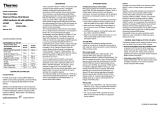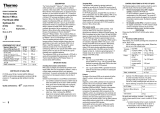Page is loading ...

PRODUCT INFORMATION
Thermo Scientific
RevertAid Reverse
Transcriptase
#EP0442 5 x 10000 U
Lot: _ Expiry Date: _
Concentration: 200 U/µL
Supplied with:
5 x 1 mL of 5X Reaction Buffer
Store at -20°C
In total 10 vials.
www.thermoscientific.com/onebio
Description
Thermo Scientific RevertAid Reverse Transcriptase (RT) is a
genetically modified M-MuLV RT. It differs from wildtype M-
MuLV RT by its structure, catalytic properties and in the
optimum activity temperature. The enzyme possesses
RNA-dependent and DNA-dependent polymerase activity
and a RNase H activity specific to RNA in RNA-DNA hybrids
which is significantly lower than that of Avian Myeloblastis
Virus (AMV) reverse transcriptase (1,2).
RevertAid™ Reverse Transcriptase activity is optimal at
42°C (active up to 50°C). The enzyme is capable of first
strand cDNA synthesis up to 13 kb. The enzyme
incorporates modified nucleotides.
Applications
• First strand cDNA synthesis for RT-PCR and real-time
RT-PCR, see protocol on back page.
• Synthesis of cDNA for cloning and expression.
• Generation of labeled cDNA probes for microarrays.
• DNA labeling (3).
• Analysis of RNA by primer extension (3).
Source
E.coli cells with a cloned fragment of the pol gene encoding
Moloney Murine Leukemia Virus reverse transcriptase.
Rev.10
V

Definition of Activity Unit
One unit of the enzyme incorporates 1 nmol of dTMP into a
polynucleotide fraction (adsorbed on DE-81) in 10 min at
37°C.
Enzyme activity is assayed in the following mixture:
50 mM Tris-HCl (pH 8.3), 4 mM MgCl2, 10 mM DTT,
50 mM KCl, 0.5 mM dTTP, 0.4 MBq/mL [3H]-dTTP,
0.4 mM polyA·oligo (dT)12-18.
Storage Buffer
The enzyme is supplied in: 50 mM Tris-HCl (pH 7.5),
0.1 M NaCl, 1 mM EDTA, 5 mM DTT,
0.1% (v/v) Triton X-100 and 50% (v/v) glycerol.
5X Reaction Buffer
250 mM Tris-HCl (pH 8.3 at 25°C), 250 mM KCl,
20 mM MgCl2, 50 mM DTT.
Inhibition and Inactivation
•
Inhibitors: metal chelators, inorganic phosphate,
pyrophosphate and polyamines (2).
•
Inactivated by heating at 70°C for 10 min.
Note
RevertAid RT has much lower RNase H activity than Avian
Myeloblastosis Virus (AMV) reverse transcriptase.
CERTIFICATE OF ANALYSIS
Endodeoxyribonuclease Assay
No conversion of covalently closed circular DNA to nicked
DNA was detected after incubation of 2000 units of
RevertAid Reverse Transcriptase with 1 µg of pUC19 DNA
for 4 hours at 37°C.
Ribonuclease Assay
No contaminating RNase activity was detected after
incubation of 200 units of RevertAid Reverse Transcriptase
with 1 µg of [3H]-RNA for 4 hours at 37°C.
Labeled Oligonucleotide (LO) Assay
No degradation of single-stranded and double-stranded
labeled oligonucleotide was observed after incubation with
400 units of RevertAid Reverse Transcriptase
for 4 hours at 37°C.
Functional Assay
RevertAid Reverse Transcriptase was tested in synthesis of
1.3 kb first strand cDNA.
Quality authorized by: Jurgita Zilinskiene
(continued on back page)

Protocol for First Strand cDNA Synthesis
The following protocol is optimized to generate first-strand
cDNA for use in two-step RT-PCR.
Mix and briefly centrifuge all components after thawing, keep
on ice.
1. Add into sterile, nuclease-free tube on ice in the indicated
order:
Template
RNA
total RNA
or
poly(A) RNA
or
specific RNA
0.1 ng-5 µg
10 pg-500 ng
0.01 pg-0.5 µg
Primer
Oligo(dT)18 (#SO131)
or
Random hexamer (#SO142)
or
gene-specific primer
0.5 µg (100 pmol)
0.2 µg (100 pmol)
15-20 pmol
DEPC-treated water (#R0601) to 12.5 µL
2. Optional: If RNA template is GC rich or is known to
contain secondary structures, mix gently, centrifuge briefly
and incubate at 65°C for 5 min, chill on ice, briefly
centrifuge and place on ice.
3. Add the following components in the indicated order:
5X Reaction Buffer 4 µL
Thermo Scientific RiboLock RNase
Inhibitor (#EO0381) 0.5 µL (20 U)
dNTP Mix, 10 mM each
(#R0191)
2 µL
(1 mM final concentration)
RevertAid Reverse Transcriptase 1 µL (200 U)
Total volume
20 µL
Mix gently and centrifuge briefly.
4. If oligo(dT)18 primer or gene-specific primer is used,
incubate 60 min at 42°C.
If random hexamer primer is used, incubate 10 min at
25°C followed by 60 min at 42°C.
For transcription of GC rich RNA reaction temperature can
be increased to 45°C.
5. Terminate the reaction by heating at 70°C for 10 min.
Do not heat-inactivate enzyme prior to analysis of long
cDNA to avoid cleavage.
Note
• The reverse transcription reaction product can be directly
used in PCR or stored at -20°C.
• Use 2 µL of the reaction mix to perform PCR in 50 µL
volume.

References
1. Verma, I.M., Reverse transcriptase, The Enzymes (Boyer, P.D., ed),
Academic Press Inc., vol. 14, 87-103, 1981.
2. Gerard, G.F. and D'Alessio, J.M., Methods in Molecular Biology,
16, Humana Press, Totowa, N.J., 73-93, 1993.
3. Sambrook, J., Russell, D.W., Molecular Cloning:
A Laboratory Manual, the third edition, Cold Spring Harbor
Laboratory Press, Cold Spring Harbor, New York, 2001.
PRODUCT USE LIMITATION
This product is developed, designed and sold exclusively for research purposes and in
vitro use only. The product was not tested for use in diagnostics or for drug
development, nor is it suitable for administration to humans or animals.
Please refer to www.thermoscientific.com/onebio for Material Safety Data Sheet of the
product.
© 2012 Thermo Fisher Scientific Inc. All rights reserved. All trademarks are the
property of Thermo Fisher Scientific Inc. and its subsidiaries.
/









